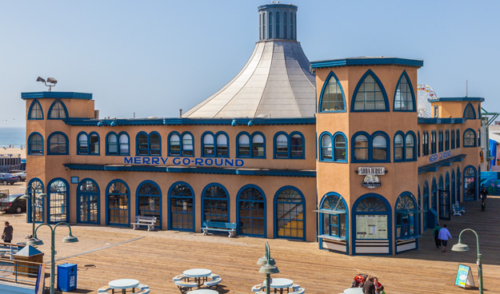Looff Hippodrome

- Known As
- The Hippodrome, Moorish-influenced
- Architect
- Various builders
- Built
- 1916
- Designated
- August 17, 1976
The Looff Hippodrome, with its charming carousel, is an architectural gem. Built in 1916, the same year as the Looff Pleasure Pier (now called Santa Monica Pier) on which it is located, the hippodrome was the last work of master carousel builder and amusement pioneer Charles I.D. Looff.
The late 19th century and early decades of the 20th century were a time of great innovation and creativity in the amusement industry and this was the golden age of the carousel. Charles Looff was at the forefront of the industry. He began his career as a furniture carver, but by the 1870s he was carving wooden horses and building whole carousels, the first of which was installed at Coney Island. Over time his company expanded and Looff successfully installed amusement areas in several states. He moved to Southern California in 1910 and in 1916 turned his attention to Santa Monica, building the Looff Pleasure Pier. The pier was a great success, in part because of its marvelous hippodrome—which, at the time, represented the very latest in modern amusements.
Many carousel buildings from this era were whimsical structures that freely mixed elements from different architectural traditions to create the most attention-getting look possible. The Looff Hippodrome was no exception. Though today the building is stripped of much of its original ornamentation, the octagonal towers on three corners of the building with their triangular Moorish style windows, and the cupola with window shutters that would fit well on a Gothic cathedral, remain. Originally the hippodrome also sported twelve smaller, striped towers that punctuated the roofline, Medieval-style crenellations crowning the corner towers, and a Russian-inspired onion dome atop the cupola.
Aside from an eclectic style, the Looff Hippodrome shares many elements typically found in carousel buildings of the era including wood-frame construction, a circular roof over the carousel, a spacious and airy floor plan, and large numbers of windows and doors that enhanced air circulation and allowed passers-by to see the marvelous machine inside.
The hippodrome’s original carousel—the last ever built by Looff—was sold and dismantled long ago. The current merry-go-round has been in place since 1954 and is historic in its own right. It was built by the Philadelphia Toboggan Company, which produced carousels unmatched in lavish detail and craftsmanship from 1899 until 1934. This carousel was moved to Santa Monica from the Venice Pier and is notable for its hand-carved wooden horses, fanciful painted upper rim, and 1,100 electric lights.
Since its heyday in the 1910s and 1920s, the Looff Hippodrome has seen its share of ups and downs, including a period of neglect in the mid-20th century. However, the building underwent major restoration in the 1980s, the carousel was restored in 1990, and today the hippodrome still delights visitors with a taste of old-fashioned fun. It was recognized as a National Historic Landmark and listed on the National Register of Historic Places in 1987.
Sources:
- Carrousel Art Magazine. Issue 14, July-August 1981 (entire issue devoted to Looff carousels).
- Frederick Fried. A Pictorial History of the Carousel. New York: Bonanza Books, 1964
- Ernest Marquez. Santa Monica Beach: A Collector’s Pictorial History. Los Angeles: Angel City Press, 2004.
- “Santa Monica, California,” Merry-Go-Roundup. Vol. 5, No. 1 (1978), p. 14-15.
- Santa Monica Landmarks Tour. Santa Monica: City Planning Division, 2004.
- Staff Report on Santa Monica Pier. City Planning Division, Santa Monica.
- Jeffrey Stanton. Santa Monica Pier: A History from 1875 to 1990. Los Angeles: Donahue Publishing, 1990.